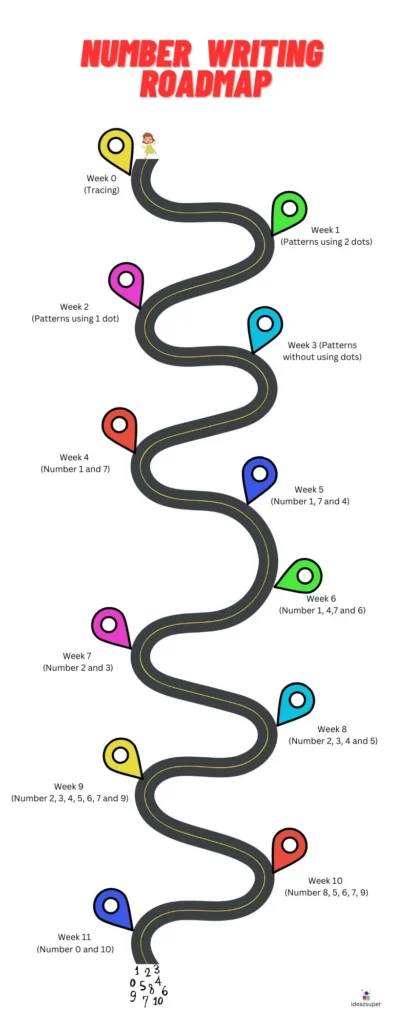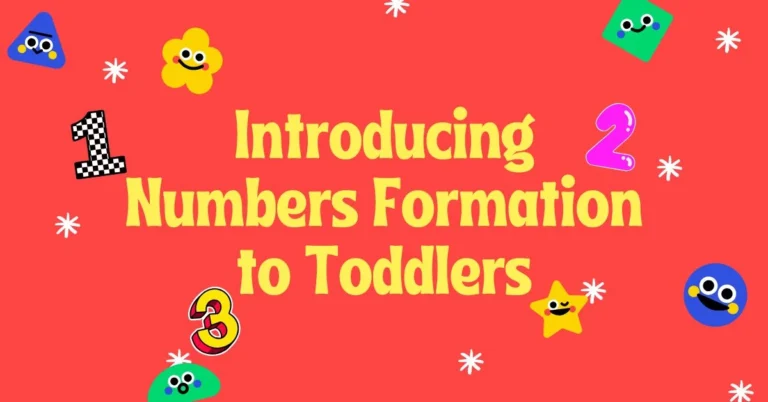In today’s digital era, developing writing skills is a big challenge for parents, as kids want to spend more time on screen. You need to be very patient, consistent, and the most important thing is to learn the right strategy to achieve this goal. Here in this article, I will guide you through the steps towards successful number formation practice for kindergarten or preschool kids.
Learning to write the alphabet and numbers is a must for every child. Usually, tracing numbers and letters is considered good for writing practice. Some parents try to use other activities, like writing in the air or sand, to understand number formation, but after that, they use tracing for writing practice.
Disadvantages of Tracing for Number Formation
Tracing is the most common way of practising number formation for kindergarten students. But it has some limitations, and some of those I will discuss here:
- During tracing, they are just using the pencil to form shapes, and their fine motor skills are not fully engaged.
- While tracing, they are following existing patterns, not using their creativity. On the other hand, independent writing allows preschoolers to explore and do experiments with letters and number formation.
- Kids become used to guides, and when they try self-writing, they might feel frustrated if they can’t replicate it without tracing.
- Tracing becomes repetitive or boring, which can decrease a child’s motivation to practice writing.
There are unconventional methods for number formation practice.
Pattern Writing
One of those methods is to learn and practice different patterns such as lines, curves, loops, and zigzag lines. Next is to move to write easy numbers and alphabet formation. This technique is very useful in early years education as it builds strong motor skills and muscle memory required to develop writing skills.
Benefits of Pattern Writing for Number Formation
Kids use their minds and understand the formation of a number using different patterns. They are:
- More independent and rely less on guides.
- Develop focus and attention to detail by using different lines correctly to form numbers.
- Repetitive practice of these patterns helps them master these and later helps them with number and alphabet formation.
- Kids feel more confident by successfully use different lines for number formation.
- Basically, it develops critical thinking skills in kids, as they will decide why or why not a line is used to form a number.
Basic Patterns for Practice
In pattern writing, children learn writing skills using 5 different patterns instead of tracing. These patterns include:
–> Sleeping lines
–> Standing lines
–> Slanting lines (left to right)
–> Slanting lines (right to left)
–> Curve
Kids can take 2 to 3 weeks to master these basic lines. It makes them ready for number handwriting formation without tears.
List and Order of Number Formation from 0-9
After the kids learned all lines and curves, the next step is to practice number writing, but here the strategy is a little changed. Kids are guided to write easier numbers first and difficult numbers later, rather than writing numbers shape system from 0-9.
Patterns in the Math Notebook
Now there is another twist, these patterns, if you teach on a block/math notebook, kids will grasp the skill to write these between a block.
Ideazsuper provides a set of worksheets to practice the patterns and then number writing, and all this can be achieved in 11 to 12 weeks. These worksheets are prepared on block/Math notebook pages, so kids are comfortable with number formation at a later stage.
Number Writing Worksheet in Steps
Step 1- In the first step, your child will learn to draw lines between the lines and 3 pages of tracing of patterns.
Step 2- In this step, children will learn to draw the patterns mentioned above using 2 dots, one dot and without any dots.
Step 3- Now your child is ready to learn numbers and alphabet writing formally.

Weekly distribution Number Writing Worksheets
You can download these free worksheets.
FAQ’s
Most children can begin basic number formation between 3–4 years old, once they can hold a pencil comfortably and draw simple lines and shapes.
Tracing helps with shape memory but doesn’t fully engage fine motor control or independent writing. Pattern writing builds muscle memory and confidence instead.
Pattern writing focuses on mastering five basic strokes — sleeping, standing, slanting (left/right), and curves. These build strong motor skills, preparing kids for number and alphabet writing.
With consistent practice, most preschoolers can master pattern writing and number formation within 11–12 weeks using IdeazSuper worksheets.
Our worksheets use math notebook blocks, helping kids learn spacing and alignment early. Each set builds from tracing to independent writing through a weekly structured plan.
Absolutely! With daily short practice sessions and the right worksheets, parents can easily support their child’s handwriting journey at home.
